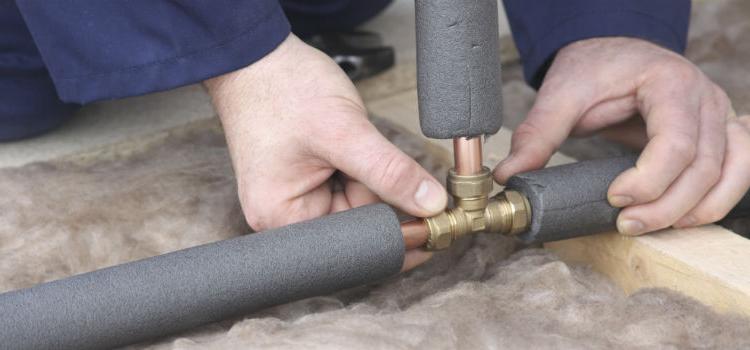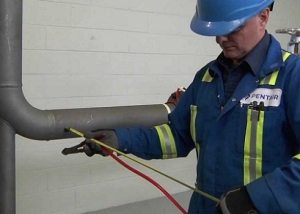The water supply system is one of the essential components of a modern private house. It is impossible to create comfortable living conditions without it. A very important point is the prevention of pipeline failure due to the influence of negative environmental factors. In winter, frost can damage both strong steel pipes and metal-plastic ones. But there is a way! It consists in organizing the insulation of water pipes in a private house.
Content
Requirements for insulation and types of materials
If we talk about pipes laid on the street, then special attention must be paid to the places of their exit to the meters and pumps. The generally accepted requirements for insulation materials include the following aspects:
- low thermal conductivity, high heat-saving properties;
- good water repellent characteristics;
- resistance to biological, chemical environmental influences;
- durability. The material should serve for many years;
- ease of installation;
- reasonable cost.
Today, in the building materials market, you can see a wide variety of heaters. Consider only those that are used most often.
Glass wool. Its other name is fiberglass insulation. It is used mainly for insulation of pipes made of metal-plastic. The most effective products are brands such as Ursa, Isover, Knauf. However, an attractive property of glass wool - low density (read, low weight), is leveled by increased hygroscopicity.
Good to know! When using it as a heater, it will be necessary to use additional external insulators such as roofing material or fiberglass.
Basalt heaters. They are produced in the form of a shell of cylindrical shape. Ease of installation is the main advantage of this building material. To provide additional protection, the basalt fiber is covered with a layer of foil isol, glassine or the same roofing material. The disadvantage of such shells is only one - high cost.
Polyfoam (aka polystyrene foam). Perhaps this is the most commonly used material when warming a water pipe in a summer house with your own hands. Laying trays for foam insulating shells is optional. On the shelves of building materials stores there are two options for this insulation: with or without additional coating.
Among other things, many owners of private houses opt for similar products also for the purpose of economy: thermal insulation from expanded polystyrene can be mounted repeatedly. And not only indoors, but outside and even in the ground.
Special thermal insulation
The principle of operation of all types of thermal insulation materials used today is the same. The role of the heat insulator in each of them is played by air, which fills the entire internal space of the insulation. Therefore, the choice of its specific type depends only on the convenience of installation and the location of the water supply line.
Multifunctional is considered to be the insulation of the water supply of a private house and cottage using tow or mineral wool.These materials, absorbing a certain amount of moisture from the air, significantly swell and acquire the ability to seal breaks that appear in the pipes. In order for the pipeline to function in winter under optimal conditions, a five-centimeter layer of insulation of this type will be sufficient.

In order for mineral wool insulation to be of high quality, the thickness of the material should be at least 5 cm
The life of the tow is as follows: 8-12 years. But the use of natural oil paint helps to increase this period of time by 2 times. Tow and mineral wool must be coated with waterproofing compounds or an additional layer of waterproofing. In the latter case, the same roofing material will do. Of the disadvantages of this method, experts highlight the high complexity of the work. As a result, the high cost of the created insulation system.
Relatively recently, a method has been developed to warm the water supply of a private house or cottage using foamed polyethylene. Today it is one of the best heat insulators. Pleases not only ease of use, but also a low price. Of the other advantages of such a heater can be distinguished:
- tolerates temperature extremes;
- not subject to decay;
- resistant to moisture;
- long service life: 25 ... 50 years.
Such a heater is produced in the form of two half-cylinders, also called shells.
Important! After you put them on the pipe, do not forget to seal the seams with tape.
Use of high pressure and air insulation
To exclude the possibility of freezing the water supply system, you can do without a heater.

You can do without pipe insulation and prevent freezing of water by maintaining a constant pressure in the system
As you know, the water supply in the country house or in a country house bursts for the reason that the ice formed inside the ice simply breaks the pipes. From a course in high school physics, it is known that the state of aggregation of pressurized water does not change, and it does not turn into ice. If the owner of the building does not plan to stay there in the winter, he can use the action of the above postulate and save money by not purchasing heat-insulating material. But as soon as the necessary pressure is created in the pipes, it is not possible to use them for their intended purpose.
To implement this method, the system will need to be supplemented with a receiver. This device maintains constant pressure in the water pipes.
The order of work is as follows:
- First you need to check the system for its ability to withstand a pressure of 5 atmospheres. The necessary information can be found by studying the passport for installed pipes. It is also necessary to study the structure for mechanical damage (specifically, cracks), since they can cause a gradual release of pressure, due to which the pipeline will freeze.
- Next, a submersible pump must be inserted into the system. He will create the pressure of the required level - about 5-7 atmospheres. A check valve is installed immediately after the pump.
- After completing these steps, turn off the tap on the receiver and turn on the pump. After the pressure reaches the set point, turn off the pump.
As a result of these simple operations, reliable protection of the trunk from freezing will be provided. Bringing the system into working condition is simple pressure release.
The essence of the method of warming with air is very simple: the water pipes are not buried directly in the ground, but pass inside pipes with a large diameter. The effect of cold is reduced due to the air gap located between the main pipeline and the soil frozen above.The heating of such a system is also carried out by natural heat coming from the bowels of the earth. You should be aware that insulation of this type will most fully fulfill its function when laying a pipeline at a depth of about 1 meter. Otherwise, its effectiveness will decrease.
Pay attention to another point. Of all ways to warm water pipes on the street this method involves the complete or partial reconstruction of the system. Therefore, it is most rational to apply it at the stage of laying the engineering communication branch.
Tips of professionals on the proper insulation of water supply:
- It is necessary to insulate all segments of the pipeline that are at a negative temperature. This requirement is relevant for places where pipes enter the house, and unheated rooms, such as basements;
- without fail, draw up a detailed diagram of the underground water supply communications on the land plot and in the house. Connecting elements are selected with particular care;
- it is necessary to carry out insulation along the entire length of the highway, without making passes for a meter;
- if the soil structure in the infield does not allow to dig pipes to a depth of more than 1 meter, it is recommended to use a special power cable for their reliable insulation. It is possible to apply voltage to it only at subzero temperature;
- if the water supply is heated by an autonomous heating system, the boiler can be turned off only in emergency cases. This method of insulation suggests that both pipes must be inside the insulation and in contact with it;
- during the winter, warm water pipes become objects of increased attention from rats, moles and other “gnawing” animals. They can gnaw through not only the insulation, but even the plastic and asbestos pipes themselves, hoping to warm themselves. You can protect the water supply line from them by plastering the pipes with a solution, adding broken glass to it, using a metal sleeve or wrapping it with a metal mesh.
Good to know! Just one drop of water frozen on the thread can damage even a steel fitting.
The use of modern materials and technologies for warming water supply pipes allows home owners to prevent freezing of the water mains, and thus ensure the flow of water even when there is a severe frost outside the window. But remember: this work should be carried out in advance, without waiting for the pipes to burst due to freezing of the liquid present in them.








